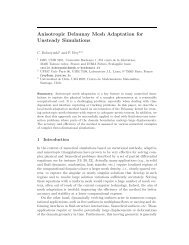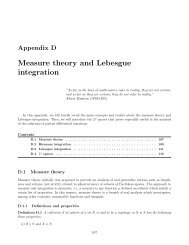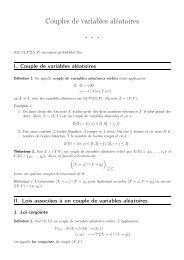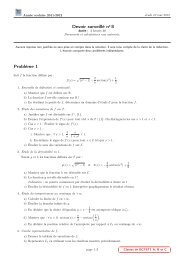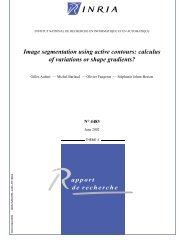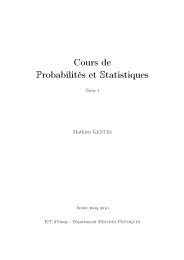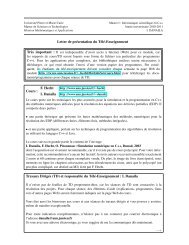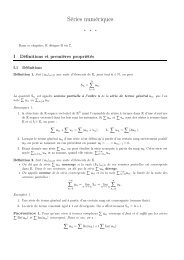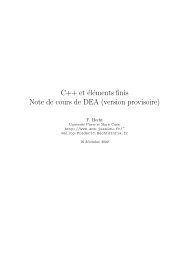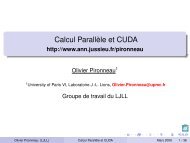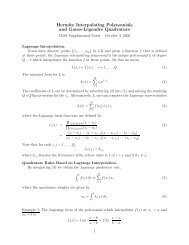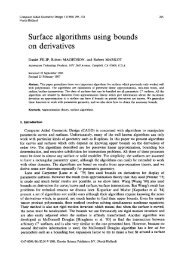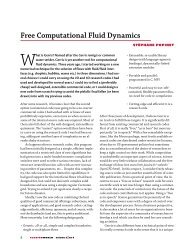pdf file
pdf file
pdf file
Create successful ePaper yourself
Turn your PDF publications into a flip-book with our unique Google optimized e-Paper software.
BOGOLIUBOV SPECTRUM OF INTERACTING BOSE GASES 13<br />
positive periodic function such that �w ≥ 0. In [24], the same method was<br />
used to treat the case of Ω = Rd , T = −∆+Vext with Vext → ∞ at infinity,<br />
and w a bounded positive function such that �w ≥ 0. In these two cases, the<br />
properties(A1), (A2) and (A3s) areall satisfied andTheorem 2 applies. The<br />
proof of strong condensation (A3s) is simple and relies on �w being positive,<br />
see, e.g., [52, Lemma 1].<br />
Thespeedofconvergence (22)thatwecanestablishinourabstractsetting<br />
is slightly worse than the O(N−1/2 ) obtained in [52, 24]. The method of<br />
proofisrather different, however. In[52, 24], theauthorsrelate HN toanNdependent<br />
Hamiltonian HBog which is quadratic in the effective annihilation<br />
operators bj = aja∗ 0 /√N −1. These operators only satisfy the commutation<br />
relations in the limit N → ∞. The effective Bogoliubov Hamiltonian HBog can be diagonalized by a unitary transform, up to an error. The unitary is<br />
constructed by inserting the effective bj’s in the formula of the Bogoliubov<br />
rotation which diagonalizes the true Hamiltonian H.<br />
Inthepresentpaper, by applyingtheunitaryUN, wesettle theproblemin<br />
theexcitedFockspaceF+,inwhichthetrueBogoliubovHamiltonianHacts.<br />
The main advantage of our approach is that F+ and H are now independent<br />
of N, which makes the comparison with UNHNU ∗ N<br />
clearer, in our opinion.<br />
The effective operators bj’s were also used in previous works [41, 42, 39] on<br />
the one- and two-component Bose gases, for which our approach could be<br />
useful as well.<br />
Let us remark that the convergence (20) in the Fock space F+ can be<br />
rewritten in the original N-body space H N as<br />
�<br />
�<br />
�Ψ (1)<br />
N −U∗ N Φ(1)<br />
�<br />
�<br />
�<br />
HN =<br />
�<br />
�<br />
�Ψ (1)<br />
N −φ(1) 0 u⊗N 0 −<br />
N�<br />
φ<br />
j=1<br />
(1)<br />
j ⊗s u ⊗(N−j)<br />
0<br />
�<br />
�<br />
�<br />
HN −→<br />
N→∞ 0<br />
where Φ (1) = φ (1)<br />
0 ⊕φ(1)<br />
1 ⊕··· ∈ F+. In particular, when w �= 0, we see that<br />
the many-body ground state Ψ (1)<br />
N<br />
is never close to the Hartree state u⊗N<br />
0 in<br />
the norm of H N . This is because the vacuum in F+ is never an eigenvector<br />
of the Bogoliubov Hamiltonian H, except when w ≡ 0. A similar property<br />
holds for the lower excited states Ψ (L)<br />
N .<br />
is in general not close to the Hartree<br />
state u ⊗N<br />
0 in the norm of HN , its density matrices are close to that of u ⊗N<br />
0 .<br />
Indeed, if (A1)-(A2)-(A3s) hold, then the convergence of eigenvectors in (iv)<br />
implies the following convergence of the one-body density matrices<br />
lim<br />
N→∞ Tr<br />
� �<br />
� �<br />
Q−γ Φ (L) � = 0<br />
and<br />
Although the wavefunction Ψ (L)<br />
N<br />
lim<br />
N→∞ Tr<br />
�<br />
�<br />
�Pγ Ψ (L)<br />
N<br />
�Qγ Ψ (L)<br />
N<br />
P −(N −N (L)<br />
+ )|u0〉〈u0|<br />
�<br />
�<br />
� = 0<br />
where P = |u0〉〈u0| = 1−Q and N (L)<br />
+ = TrγΦ (L). In particular, by simply<br />
controlling the cross term Pγ (L)<br />
N Q by the Cauchy-Schwarz inequality, we<br />
immediately obtain the complete Bose-Einstein condensation<br />
�<br />
�<br />
Tr<br />
�N −1 γ Ψ (L)<br />
N<br />
�<br />
�<br />
−|u0〉〈u0| � ≤ O(N −1/2 ).



